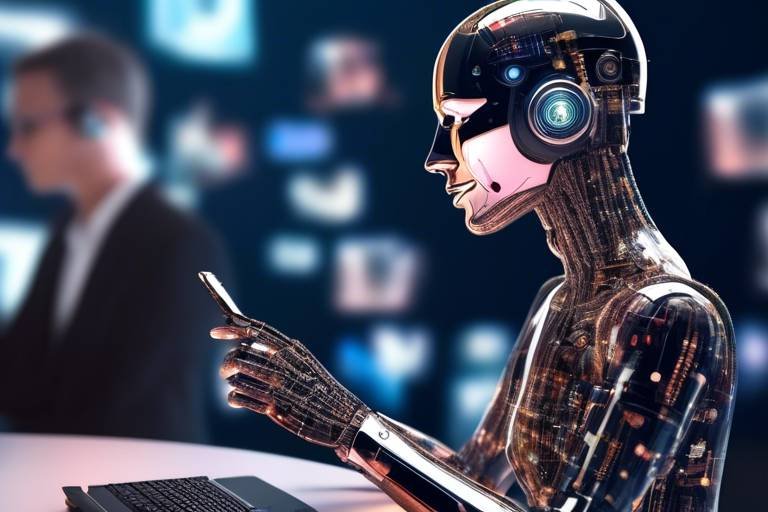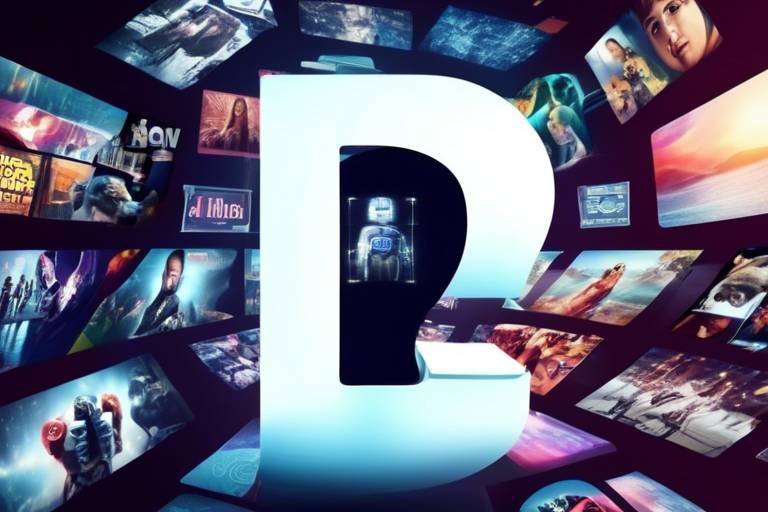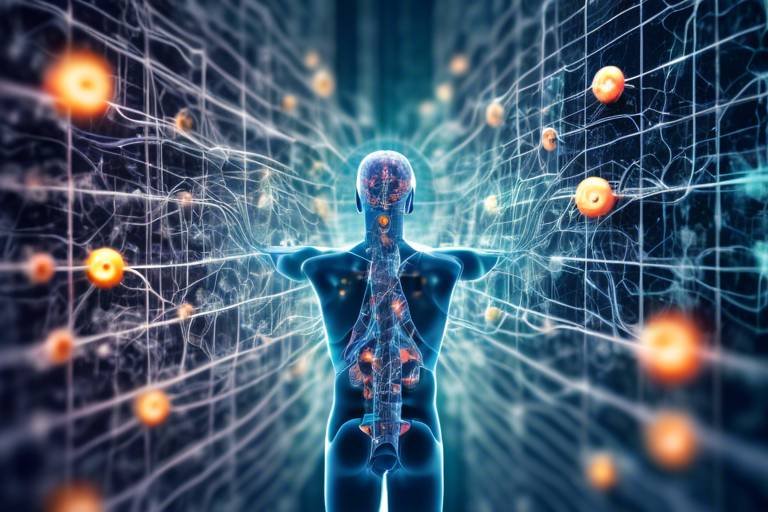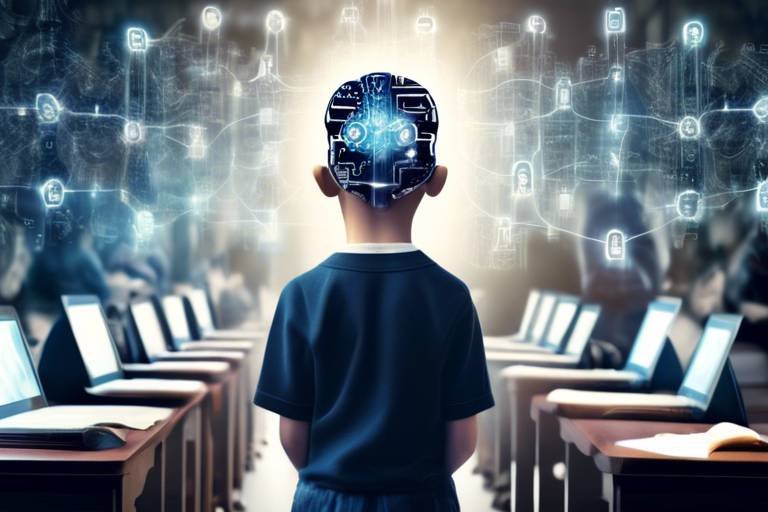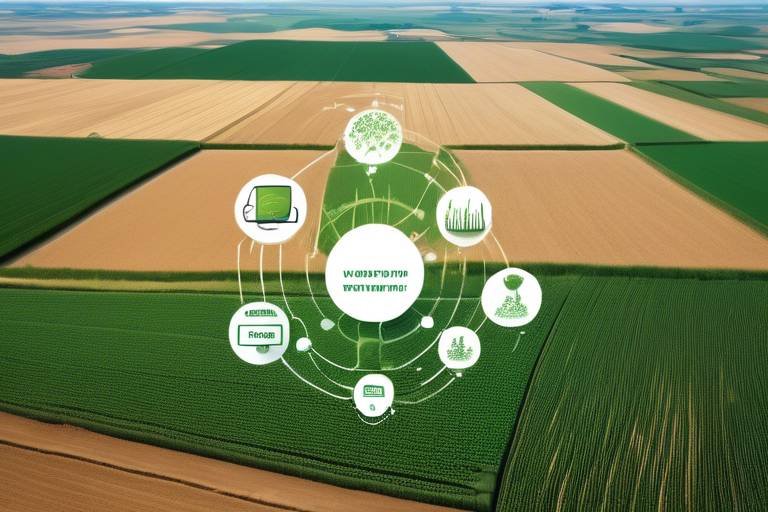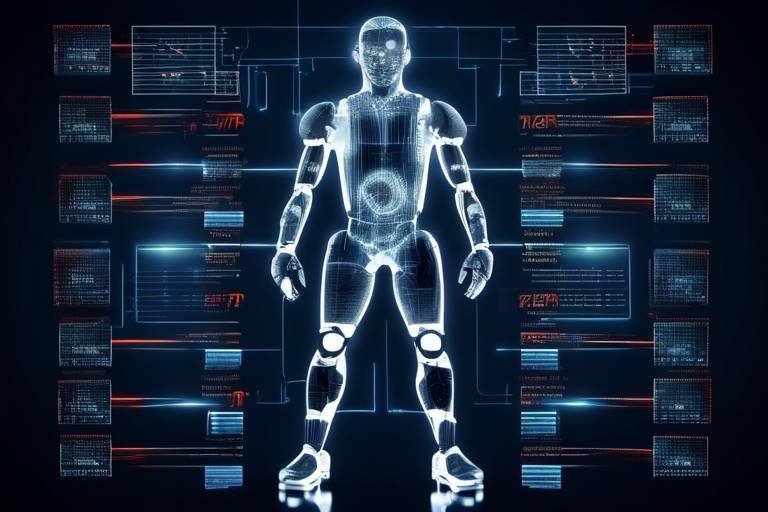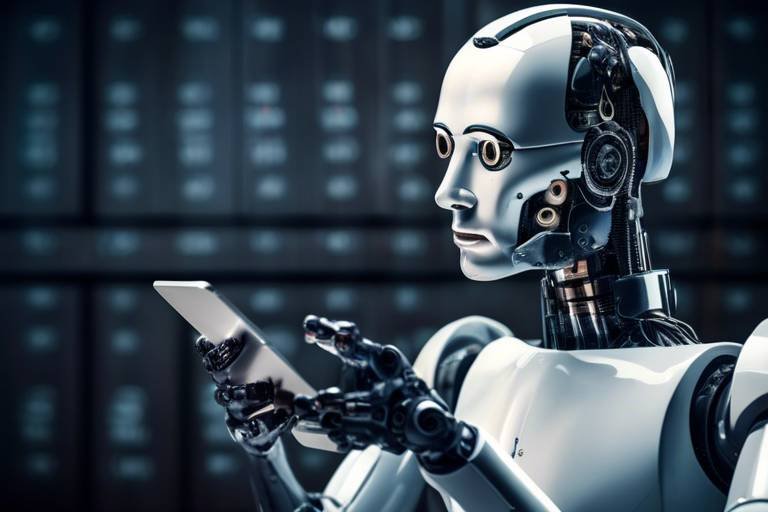Impact of Machine Learning on Health Diagnostics
In today's fast-paced world, the integration of machine learning into health diagnostics is nothing short of revolutionary. Imagine a world where doctors can diagnose diseases with pinpoint accuracy in a fraction of the time it used to take. This is not just a dream; it's becoming a reality. Machine learning algorithms are transforming how we approach healthcare, allowing for more precise and efficient diagnostics. By analyzing vast amounts of medical data, these algorithms can uncover patterns and insights that would be nearly impossible for humans to detect. This article explores the transformative effects of machine learning in health diagnostics, highlighting its benefits, challenges, and potential future developments in the medical field.
Machine learning is reshaping the healthcare landscape by enhancing diagnostic accuracy and streamlining processes. The technology leverages data-driven insights to assist healthcare professionals in making informed decisions. In clinical settings, the integration of machine learning can lead to a more efficient workflow, enabling healthcare providers to focus more on patient care rather than administrative tasks. The beauty of machine learning lies in its ability to learn from data continuously. As more data becomes available, these systems improve, refining their algorithms and enhancing their predictive capabilities.
One of the most significant advantages of machine learning in diagnostics is its ability to improve accuracy in disease detection. Traditional diagnostic methods can sometimes miss subtle signs of disease, leading to delayed treatment and poor patient outcomes. In contrast, machine learning algorithms can analyze extensive datasets quickly, identifying patterns that may go unnoticed by the human eye. This capability not only reduces human error but also allows for earlier detection of diseases, which can be crucial in conditions like cancer and heart disease.
Consider the case of breast cancer detection. Machine learning models trained on thousands of mammogram images have shown to outperform human radiologists in identifying malignant tumors. This is a game-changer for early diagnosis and treatment. The algorithms can process images and data at lightning speed, offering insights that lead to more accurate diagnoses. The result? Patients receive timely interventions that significantly improve their chances of recovery.
Several case studies highlight the successful application of machine learning in diagnosing various conditions:
- Cancer Detection: A prominent study demonstrated that a machine learning algorithm could identify breast cancer with over 94% accuracy, surpassing human radiologists.
- Diabetes Management: Machine learning tools are now used to predict diabetic complications by analyzing patient data and lifestyle factors, allowing for personalized treatment plans.
- Cardiovascular Diseases: Algorithms are being developed to predict heart disease risk by evaluating a patient’s medical history and genetic information.
These real-world impacts show how machine learning is not just a theoretical concept but a practical tool that enhances patient care.
When comparing machine learning techniques with traditional diagnostic methods, the differences in efficiency and precision become evident. Traditional methods often rely on manual interpretation of tests and images, which can introduce variability and bias. In contrast, machine learning systems analyze data consistently and objectively. For instance, a table summarizing the key differences between these approaches might look like this:
| Aspect | Traditional Methods | Machine Learning Methods |
|---|---|---|
| Data Processing | Manual interpretation | Automated analysis |
| Speed | Time-consuming | Rapid processing |
| Accuracy | Variable | High and consistent |
| Learning Capability | Static | Dynamic and improving |
Despite its advantages, the implementation of machine learning in health diagnostics is not without challenges. Data privacy concerns loom large as sensitive patient information is processed by algorithms. Moreover, algorithm bias can lead to disparities in care if the training datasets are not representative of the diverse patient population. Additionally, the need for extensive training datasets can be a hurdle, as collecting and curating quality data is a significant undertaking.
Looking ahead, the future of machine learning in health diagnostics is bright. Emerging trends such as advancements in deep learning and natural language processing promise to further enhance diagnostic capabilities. These technologies can analyze not just structured data, but also unstructured data like clinical notes and research articles, providing a comprehensive view of patient health.
The integration of machine learning with telemedicine platforms is poised to revolutionize remote diagnostics. Imagine being able to receive a timely and accurate assessment from the comfort of your home, especially for patients in underserved areas. This synergy between machine learning and telemedicine can bridge gaps in healthcare access, ensuring that quality care is available to everyone, regardless of location.
As machine learning continues to evolve, addressing regulatory and ethical considerations becomes crucial. Ensuring patient safety and maintaining trust in AI-driven diagnostic tools is paramount. Regulatory bodies will need to establish guidelines that ensure transparency and accountability in machine learning applications, ultimately fostering a healthcare environment where technology and human expertise work hand in hand.
Q: What is machine learning in healthcare?
A: Machine learning in healthcare refers to the use of algorithms and statistical models to analyze and interpret complex medical data, leading to improved diagnostic accuracy and patient care.
Q: How does machine learning improve diagnostics?
A: Machine learning enhances diagnostics by identifying patterns in large datasets that humans may overlook, resulting in earlier and more accurate disease detection.
Q: What are the challenges of implementing machine learning in healthcare?
A: Challenges include data privacy concerns, algorithm bias, and the need for extensive and diverse training datasets.
Q: What is the future of machine learning in health diagnostics?
A: The future includes advancements in deep learning and natural language processing, as well as integration with telemedicine, promising a more efficient and accessible healthcare system.

Introduction to Machine Learning in Healthcare
Machine learning is not just a buzzword; it's a game changer in the realm of healthcare diagnostics. Imagine a world where doctors can diagnose diseases with the precision of a hawk spotting its prey from miles away. That's the power of machine learning! By leveraging vast amounts of data, these intelligent algorithms can uncover patterns and insights that would take human experts years to discover. This technology is revolutionizing the way we think about health diagnostics, making it more accurate, efficient, and personalized.
As healthcare systems globally grapple with rising patient numbers and complex medical conditions, the integration of machine learning offers a lifeline. With its ability to process and analyze data at lightning speed, machine learning helps clinicians make informed decisions faster than ever. For instance, consider a scenario where a patient presents symptoms that could indicate multiple conditions. A machine learning system can swiftly analyze the patient's medical history, genetic information, and even lifestyle factors to suggest the most likely diagnosis, allowing doctors to focus on what truly matters—patient care.
However, the journey of integrating machine learning into healthcare is not without its bumps. There are challenges to overcome, such as ensuring data privacy and addressing algorithmic biases. Yet, the potential benefits far outweigh these hurdles. For example, hospitals using machine learning tools have reported significant improvements in diagnostic accuracy, which not only enhances patient outcomes but also reduces healthcare costs by minimizing unnecessary tests and procedures.
In a nutshell, the marriage of machine learning and healthcare is akin to pairing a fine wine with gourmet cuisine—it enhances the overall experience and leads to exceptional results. As we delve deeper into this topic, we'll uncover the numerous advantages machine learning brings to diagnostics, explore real-world case studies, and discuss the challenges that lie ahead. Stay tuned as we embark on this enlightening journey through the world of machine learning in healthcare!
- What is machine learning in healthcare?
Machine learning in healthcare refers to the use of algorithms and statistical models to analyze and interpret complex medical data, enabling improved diagnostics and treatment plans. - How does machine learning improve diagnostic accuracy?
By analyzing large datasets, machine learning algorithms can identify patterns and anomalies that might be missed by human clinicians, leading to more accurate diagnoses. - What are the challenges of implementing machine learning in healthcare?
Challenges include data privacy concerns, potential biases in algorithms, and the need for extensive, high-quality training datasets. - What is the future of machine learning in health diagnostics?
The future includes advancements in deep learning and natural language processing, enhancing diagnostic capabilities and integrating with telemedicine for remote assessments.

Benefits of Machine Learning in Diagnostics
Machine learning is not just a buzzword in the tech industry; it’s a game-changer in the field of healthcare diagnostics. Imagine having the ability to sift through mountains of medical data in the blink of an eye, identifying patterns and anomalies that even the most skilled human eyes might miss. This is precisely what machine learning brings to the table. By leveraging advanced algorithms, healthcare providers can enhance accuracy in disease detection, streamline processes, and ultimately improve patient outcomes. In this section, we will delve into the myriad benefits that machine learning offers in the realm of diagnostics.
One of the most significant advantages of machine learning is its enhanced accuracy in disease detection. Traditional diagnostic methods often rely on subjective interpretations and can be prone to human error. However, machine learning algorithms analyze vast datasets, extracting insights that lead to more precise diagnoses. For instance, a machine learning model trained on thousands of medical images can identify early signs of conditions like cancer with remarkable accuracy. This not only reduces misdiagnoses but also enables earlier interventions, which can be crucial for patient survival.
Furthermore, the speed at which machine learning processes medical data is astonishing. In an era where time is of the essence, especially in emergency situations, the ability to quickly analyze test results and imaging can be lifesaving. For example, consider a scenario where a patient arrives at the emergency room with chest pain. A machine learning system can rapidly analyze their past medical history, current symptoms, and even real-time data from wearable devices to provide a comprehensive risk assessment. This allows healthcare professionals to make informed decisions almost instantaneously.
Another compelling benefit is the potential for personalized treatment plans. Machine learning enables the creation of tailored therapies based on individual patient data. By analyzing genetic information, lifestyle factors, and previous treatment responses, healthcare providers can develop customized treatment strategies that are more effective. This level of personalization is a significant shift from the one-size-fits-all approach that has dominated healthcare for decades. It’s akin to having a bespoke suit tailored just for you, rather than settling for something off the rack.
To illustrate the impact of machine learning, let’s take a look at a few case studies:
| Condition | Machine Learning Application | Outcome |
|---|---|---|
| Cancer | AI algorithms analyzing mammograms | Increased detection rates by 20% |
| Diabetes | Predictive modeling for blood sugar levels | Improved management and reduced complications |
| Cardiovascular Diseases | Risk assessment using patient data | Early intervention leading to better outcomes |
When we compare machine learning techniques with traditional diagnostic methods, the differences are striking. Traditional methods often rely on manual analysis and subjective interpretation, which can be time-consuming and error-prone. In contrast, machine learning algorithms can process and analyze data at an unprecedented scale and speed. This efficiency not only saves time but also allows healthcare providers to focus on what they do best: caring for patients. Imagine a world where doctors spend less time on administrative tasks and more time engaging with patients; that’s the promise machine learning holds.
In conclusion, the benefits of machine learning in diagnostics are profound. From enhancing accuracy and speeding up data processing to enabling personalized treatment plans, it’s clear that this technology is reshaping the future of healthcare. As we continue to integrate machine learning into clinical settings, the potential for improved patient outcomes becomes even more exciting.
- What is machine learning? Machine learning is a subset of artificial intelligence that uses algorithms to analyze data, learn from it, and make predictions or decisions without human intervention.
- How does machine learning improve diagnostics? By analyzing large datasets, machine learning algorithms can identify patterns and anomalies that may be missed by human practitioners, leading to more accurate diagnoses.
- Are there any risks associated with machine learning in healthcare? Yes, challenges such as data privacy, algorithm bias, and the need for extensive training datasets must be addressed to ensure safe and effective use.

Enhanced Accuracy in Disease Detection
When we think about health diagnostics, accuracy is the name of the game. Imagine a world where a simple scan or test can reveal a disease with pinpoint precision—this is where machine learning steps in as a game changer. By leveraging complex algorithms, machine learning can sift through mountains of data, identifying patterns that the human eye might miss. This capability significantly reduces the chances of misdiagnosis and enhances the overall efficiency of healthcare systems.
For instance, consider the detection of cancers. Traditional methods often rely on a mix of imaging and subjective interpretation by radiologists, which can lead to inconsistencies. However, machine learning algorithms can analyze thousands of scans, learning from each one to improve their accuracy over time. This data-driven approach not only boosts the chances of early detection but also tailors the diagnostic process to individual patients, thus enhancing outcomes.
Moreover, the accuracy of these algorithms can be illustrated through case studies. In one notable instance, a machine learning model developed by researchers at Stanford University was able to diagnose skin cancer with an accuracy comparable to that of experienced dermatologists. This breakthrough demonstrates how technology can augment human capability, ensuring that patients receive timely and correct diagnoses.
To further highlight the impact of machine learning, let’s take a look at some key aspects:
| Diagnostic Method | Accuracy Rate | Machine Learning Advantage |
|---|---|---|
| Traditional Imaging | 75-85% | Subjective interpretation; varies by clinician |
| Machine Learning Algorithms | 90-95% | Data-driven; consistent and objective analysis |
In addition to cancers, machine learning is proving beneficial in diagnosing chronic diseases such as diabetes and cardiovascular conditions. By analyzing data from various sources, including electronic health records and wearable devices, machine learning models can identify risk factors and predict disease onset with remarkable accuracy. This proactive approach enables healthcare providers to implement preventive measures, ultimately leading to better patient management.
However, it’s essential to recognize that while machine learning enhances accuracy, it is not without its challenges. The reliance on large datasets means that the quality of the input data is crucial. If the data is biased or incomplete, the outcomes can be skewed, potentially leading to inaccurate diagnoses. Therefore, continuous monitoring and validation of these algorithms are necessary to maintain their effectiveness.
In conclusion, the enhanced accuracy in disease detection facilitated by machine learning is not just a technological advancement; it represents a fundamental shift in how we approach health diagnostics. As we continue to explore this exciting frontier, the potential for improved patient outcomes is immense, paving the way for a future where healthcare is not only reactive but also proactive.
- What is machine learning in healthcare?
Machine learning in healthcare refers to the use of algorithms and statistical models to analyze and interpret complex medical data, enhancing diagnostic accuracy and treatment planning. - How does machine learning improve disease detection?
Machine learning improves disease detection by analyzing vast datasets to identify patterns and anomalies that may indicate the presence of diseases, reducing the likelihood of human error. - Are there any risks associated with machine learning in diagnostics?
Yes, risks include data privacy concerns, algorithm bias, and the need for high-quality training data to ensure accurate outcomes.

Case Studies of Successful Implementations
Throughout the healthcare landscape, the integration of machine learning has led to remarkable advancements in diagnostics. One prominent example is the application of machine learning in detecting breast cancer. A study conducted by researchers at Google Health demonstrated that their algorithm could analyze mammogram images with an accuracy that surpassed human radiologists. In this study, the AI model was trained on a dataset of over 90,000 mammograms, enabling it to identify subtle patterns that might be overlooked by the human eye. This not only reduced false positives by 5.7% but also decreased false negatives by 9.4%, ultimately leading to earlier interventions and improved patient outcomes.
Another compelling case study involves the use of machine learning in diagnosing diabetes. Researchers at Stanford University developed a model that analyzes electronic health records (EHRs) to predict the onset of diabetes up to five years in advance. By examining various factors, including age, body mass index (BMI), and blood test results, the model achieved an impressive accuracy rate of over 80%. This proactive approach allows healthcare providers to implement preventive measures and lifestyle changes, thus reducing the likelihood of diabetes-related complications.
Furthermore, the field of cardiovascular health has also benefitted from machine learning innovations. A notable project involved the use of AI algorithms to analyze cardiac imaging data. In a clinical trial, machine learning models were utilized to assess the risk of heart disease based on echocardiograms. The results indicated that the AI was able to identify high-risk patients with a precision that rivaled traditional diagnostic methods. This capability not only streamlines the diagnostic process but also ensures that patients receive timely and targeted interventions.
These case studies exemplify the transformative power of machine learning in health diagnostics, showcasing how AI can enhance accuracy and efficiency in identifying diseases. However, it’s essential to recognize that while these implementations are promising, they also underscore the importance of rigorous testing and validation to ensure that AI-driven tools are reliable and safe for widespread clinical use.
- What is machine learning in healthcare?
Machine learning in healthcare refers to the use of algorithms and statistical models to analyze and interpret complex medical data, enabling improved diagnostics and treatment planning. - How does machine learning improve diagnostic accuracy?
By analyzing vast amounts of data, machine learning algorithms can identify patterns and anomalies that may not be evident to human practitioners, leading to more accurate disease detection. - Are there any risks associated with machine learning in health diagnostics?
Yes, challenges such as data privacy concerns, algorithm bias, and the need for comprehensive training datasets pose significant risks that must be addressed to ensure safe implementation. - What future trends can we expect in machine learning for health diagnostics?
Emerging trends include advancements in deep learning and natural language processing, which will further enhance diagnostic capabilities and integration with telemedicine platforms.

Comparison with Traditional Diagnostic Methods
When we think about the evolution of healthcare diagnostics, it's hard not to get excited about the potential of machine learning (ML). Traditional diagnostic methods, while foundational to modern medicine, often rely heavily on human intuition, experience, and sometimes, sheer luck. In contrast, machine learning algorithms can process vast amounts of data at lightning speed, leading to insights that would take humans years to uncover. Imagine having a super-smart assistant that never tires, never makes mistakes due to fatigue, and can sift through millions of patient records in seconds. That's the power of ML!
One significant difference between traditional methods and ML is the approach to data analysis. Traditional diagnostics often depend on clinical guidelines and a physician's judgment, which can be subjective. For instance, a doctor might interpret a set of symptoms based on their training and experience, but what if there’s a rare disease that they’ve never encountered? This is where machine learning shines, as it can identify patterns in data that even the most seasoned professionals might overlook. By analyzing historical data from thousands of patients, ML can highlight correlations that lead to earlier and more accurate diagnoses.
To illustrate this point further, consider the following table that compares key aspects of traditional diagnostic methods with machine learning approaches:
| Aspect | Traditional Methods | Machine Learning Methods |
|---|---|---|
| Data Processing Speed | Slower, manual analysis | Fast, automated analysis |
| Accuracy | Subject to human error | High accuracy through pattern recognition |
| Scalability | Limited to individual cases | Can analyze large datasets simultaneously |
| Personalization | Generalized treatment plans | Tailored treatment based on individual data |
Moreover, machine learning can also enhance the diagnostic process by integrating multiple data sources. Traditional methods often rely on isolated tests, such as blood work or imaging studies, which may not provide a complete picture of a patient's health. In contrast, ML can aggregate information from various sources—like electronic health records, genetic data, and even wearable health devices—to create a comprehensive view of a patient’s condition. This holistic approach not only improves diagnostic accuracy but also enables healthcare providers to develop more effective treatment plans.
However, it’s essential to acknowledge that machine learning isn't a panacea. While it offers remarkable advantages, it still requires a foundation built on quality data and robust algorithms. There can be instances where ML models may misinterpret data, leading to incorrect conclusions. Thus, the ideal scenario is a collaborative approach where machine learning tools augment the expertise of healthcare professionals, leading to better patient outcomes.
In conclusion, the comparison between traditional diagnostic methods and machine learning reveals a landscape ripe for transformation. While traditional methods have served us well, the integration of machine learning brings forth a new era of diagnostics—one that promises enhanced accuracy, faster results, and personalized care. As we continue to explore this exciting frontier, the ultimate goal remains clear: improving patient health and well-being through innovative technology.
- What is machine learning in healthcare? Machine learning in healthcare refers to the use of algorithms and statistical models to analyze and interpret complex medical data, enhancing diagnostic accuracy and treatment plans.
- How does machine learning improve disease detection? Machine learning improves disease detection by analyzing large datasets to identify patterns and correlations that may be missed by human practitioners.
- What are the challenges of implementing machine learning in diagnostics? Challenges include data privacy concerns, algorithm bias, and the need for extensive training datasets to ensure accuracy.
- Will machine learning replace doctors? No, machine learning is intended to assist healthcare professionals, not replace them. It enhances their capabilities and supports better decision-making.

Challenges in Implementing Machine Learning
The integration of machine learning into health diagnostics is not without its hurdles. While the potential benefits are immense, several challenges can impede the widespread adoption of these technologies. One of the most pressing issues is data privacy. As healthcare systems increasingly rely on vast amounts of patient data to train machine learning models, concerns about how this sensitive information is stored, shared, and protected arise. Patients expect their health information to be confidential, and any breach could lead to a significant loss of trust in healthcare providers and technologies.
Another challenge is algorithm bias. Machine learning models are only as good as the data they are trained on. If the training datasets are not diverse or representative of the entire population, the algorithms may produce biased results. For instance, a model trained predominantly on data from one demographic group may not perform well when applied to another group, leading to disparities in diagnosis and treatment. This can exacerbate existing health inequalities, making it crucial to ensure that training datasets are comprehensive and inclusive.
Moreover, the need for extensive training datasets cannot be overstated. Developing accurate machine learning models requires large amounts of high-quality data. In many cases, healthcare institutions may struggle to gather sufficient data due to regulations, lack of interoperability between systems, or simply because of the sheer volume of data needed. This scarcity can stifle innovation and slow down the implementation of machine learning solutions in clinical settings.
To illustrate these challenges, consider the following table that summarizes key obstacles in implementing machine learning in health diagnostics:
| Challenge | Description |
|---|---|
| Data Privacy | Concerns regarding the protection and confidentiality of patient data. |
| Algorithm Bias | Risk of biased outcomes due to unrepresentative training datasets. |
| Data Scarcity | Insufficient high-quality data hampers model training and accuracy. |
Additionally, there is the challenge of acceptance and trust among healthcare professionals and patients. Many practitioners may be hesitant to rely on machine learning tools, fearing that these technologies could undermine their expertise or lead to misdiagnoses. Building trust in these systems is essential, and it can be achieved through rigorous validation studies and transparent communication about how these tools work and their limitations.
In conclusion, while the challenges of implementing machine learning in health diagnostics are significant, they are not insurmountable. Addressing these issues head-on through collaboration between technologists, healthcare providers, and policymakers will pave the way for more effective and equitable healthcare solutions.
- What is machine learning in healthcare? Machine learning in healthcare refers to the use of algorithms and statistical models to analyze and interpret complex medical data, improving diagnostic accuracy and treatment outcomes.
- What are the benefits of using machine learning for diagnostics? Benefits include enhanced accuracy, quicker data processing, and the ability to create personalized treatment plans based on individual patient data.
- What challenges does machine learning face in healthcare? Key challenges include data privacy concerns, algorithm bias, the need for extensive training datasets, and acceptance among healthcare professionals.
- How can we ensure the ethical use of machine learning in healthcare? Ensuring ethical use involves addressing regulatory considerations, maintaining patient confidentiality, and ensuring that algorithms are trained on diverse datasets.

Future Trends in Machine Learning for Health Diagnostics
As we look ahead, the landscape of health diagnostics is set to undergo a remarkable transformation, driven primarily by advancements in machine learning. This technology is not just a passing trend; it is a robust tool that promises to redefine how we approach health diagnostics in the coming years. With the continuous evolution of algorithms and computational power, we can expect several exciting trends to emerge.
One of the most promising areas is the advancement of deep learning, which mimics the human brain's neural networks to process data. This technique has already shown significant potential in image recognition tasks, such as analyzing medical images for early signs of diseases like cancer. As deep learning models become more sophisticated, they will likely improve the accuracy and speed of diagnostics, allowing healthcare professionals to make quicker, more informed decisions.
Moreover, the integration of natural language processing (NLP) into health diagnostics is another trend to watch. NLP can analyze unstructured data from clinical notes, patient histories, and even social media to extract valuable insights. Imagine a scenario where a healthcare provider can quickly assess a patient’s background and symptoms through a simple voice command or text input. This capability can enhance patient interactions and streamline diagnostic processes, making healthcare more efficient and less time-consuming.
Additionally, the convergence of machine learning with telemedicine is poised to revolutionize remote diagnostics. With the rise of telehealth platforms, machine learning algorithms can analyze patient data in real-time, providing timely and accurate assessments. For patients in underserved areas, this means access to quality healthcare without the need for physical travel. The potential for machine learning to assist in remote diagnostics is immense, bridging the gap between patients and healthcare providers.
However, as we embrace these advancements, we must also consider the regulatory and ethical implications. The integration of machine learning into health diagnostics raises important questions about data privacy, algorithm bias, and the need for transparency in AI-driven tools. To ensure patient safety and maintain trust in these technologies, regulatory bodies will need to develop comprehensive guidelines that address these concerns. This balance between innovation and ethics will be crucial in shaping the future of health diagnostics.
In summary, the future of machine learning in health diagnostics is bright and full of potential. With advancements in deep learning, natural language processing, and telemedicine integration, we can expect a healthcare landscape that is not only more efficient but also more personalized. As we navigate these changes, it is essential to remain vigilant about the ethical considerations that accompany such powerful technologies.
- What is machine learning in health diagnostics?
Machine learning in health diagnostics refers to the use of algorithms and statistical models to analyze medical data, improving the accuracy and efficiency of disease detection and patient care.
- How does deep learning enhance diagnostic accuracy?
Deep learning enhances diagnostic accuracy by processing vast amounts of data, enabling the identification of patterns and anomalies that may not be visible to the human eye.
- What role does natural language processing play in healthcare?
NLP plays a crucial role in healthcare by analyzing unstructured data from patient records, helping to extract meaningful insights and improve communication between patients and providers.
- Are there ethical concerns regarding machine learning in healthcare?
Yes, there are ethical concerns, including data privacy, algorithm bias, and the need for transparency in AI systems, which must be addressed to ensure patient safety and trust.

Integration with Telemedicine
The integration of machine learning with telemedicine is not just a trend; it's a revolution that is reshaping how healthcare is delivered, especially in remote and underserved areas. Imagine being able to consult a doctor without leaving your home, and having advanced algorithms assist in diagnosing your condition in real-time. This is no longer a distant dream but a reality that is unfolding before our eyes.
Telemedicine has already made significant strides in enhancing access to healthcare, but when paired with machine learning, it takes the concept to another level. For instance, machine learning algorithms can analyze patient data collected during virtual consultations, identifying patterns that might escape the human eye. This technology can flag potential health issues and suggest further tests or treatments, ensuring that patients receive timely and accurate assessments.
Moreover, the synergy between these two fields can lead to:
- Improved Diagnosis Speed: Machine learning can process vast amounts of data faster than any human, allowing for quicker diagnoses during telemedicine sessions.
- Personalized Treatment Plans: By analyzing a patient's medical history and symptoms, machine learning can help tailor treatment plans that are uniquely suited to each individual.
- Enhanced Monitoring: Patients with chronic conditions can benefit from continuous monitoring through telemedicine platforms, with machine learning algorithms alerting healthcare providers of any significant changes in their health status.
However, the integration of machine learning in telemedicine is not without its challenges. Issues such as data security, algorithm transparency, and the need for healthcare professionals to understand these technologies are crucial to address. As we move forward, ensuring that both patients and providers are well-informed about how these systems work will be essential in building trust and maximizing the benefits.
In summary, the marriage of machine learning and telemedicine is paving the way for a more efficient, accessible, and personalized healthcare experience. As technology continues to advance, we can expect to see even more innovative solutions that will transform patient care, making it more proactive rather than reactive. The future of healthcare is here, and it’s smarter than ever before!
- What is telemedicine? - Telemedicine refers to the remote diagnosis and treatment of patients through telecommunications technology.
- How does machine learning enhance telemedicine? - Machine learning improves telemedicine by analyzing patient data for faster diagnoses, personalized treatment plans, and enhanced monitoring of chronic conditions.
- Are there any risks associated with using machine learning in telemedicine? - Yes, challenges include data privacy concerns, algorithm bias, and the need for healthcare professionals to be trained in these technologies.
- What are the potential future developments in this area? - Future developments may include more sophisticated algorithms, better integration with wearable devices, and improved regulatory frameworks to ensure patient safety.

Regulatory and Ethical Considerations
The rapid advancement of machine learning in health diagnostics brings with it a plethora of regulatory and ethical challenges that cannot be overlooked. As healthcare increasingly relies on algorithms to guide clinical decisions, it is essential to establish robust frameworks to ensure patient safety and uphold ethical standards. One of the primary concerns is the need for data privacy. Patients' medical records are sensitive, and the integration of machine learning systems necessitates stringent measures to protect personal information from breaches and unauthorized access.
Moreover, there is a growing apprehension regarding algorithm bias. Machine learning models are trained on historical data, which may reflect existing biases in healthcare. If these biases are not addressed, they can lead to unequal treatment outcomes across different demographics. For instance, if a model is predominantly trained on data from one ethnic group, it may perform poorly for patients from other backgrounds, potentially exacerbating health disparities.
To tackle these issues, regulatory bodies must develop comprehensive guidelines that govern the use of machine learning in healthcare. This includes establishing standards for data collection, ensuring transparency in how algorithms are developed, and mandating regular audits of AI systems to identify and rectify biases. Additionally, the informed consent process must be reevaluated. Patients should be made aware of how their data will be used in training machine learning models and the potential implications of these technologies on their care.
Another critical aspect is the need for interdisciplinary collaboration. Healthcare professionals, data scientists, ethicists, and regulators must work together to create a holistic approach to machine learning in diagnostics. This collaboration can help ensure that ethical considerations are embedded in the development and deployment of these technologies, fostering trust among patients and healthcare providers alike.
In conclusion, while the integration of machine learning in health diagnostics holds immense potential, it is vital to address the regulatory and ethical considerations that accompany its implementation. By doing so, we can harness the power of AI while safeguarding the rights and well-being of patients, ensuring that technological advancements do not come at the cost of ethical integrity.
- What are the key ethical concerns related to machine learning in healthcare?
Key concerns include data privacy, algorithm bias, and the need for informed consent from patients regarding how their data is used.
- How can algorithm bias affect patient care?
Algorithm bias can lead to unequal treatment outcomes, particularly if the training data does not adequately represent diverse populations.
- What role do regulatory bodies play in machine learning applications in healthcare?
Regulatory bodies establish guidelines to ensure patient safety, data protection, and ethical standards in the development and use of machine learning technologies.
Frequently Asked Questions
- What is machine learning in healthcare?
Machine learning in healthcare refers to the use of algorithms and statistical models to analyze and interpret complex medical data. It helps in automating diagnostics, predicting outcomes, and personalizing treatment plans, ultimately enhancing patient care.
- How does machine learning improve disease detection?
Machine learning improves disease detection by analyzing large datasets to identify patterns that may not be visible to the human eye. This leads to more accurate diagnoses and reduces the likelihood of human error, ensuring better patient outcomes.
- What are some benefits of using machine learning in diagnostics?
The benefits include enhanced accuracy in disease detection, faster processing of medical data, and the ability to create personalized treatment plans. This technology can significantly improve the efficiency and effectiveness of healthcare services.
- What challenges does machine learning face in health diagnostics?
Challenges include data privacy concerns, potential algorithm bias, and the necessity for extensive and high-quality training datasets. Addressing these issues is crucial for the successful implementation of machine learning in healthcare.
- How is machine learning integrated with telemedicine?
Machine learning is integrated with telemedicine to enhance remote diagnostics. It enables healthcare professionals to provide timely and accurate assessments, especially for patients in underserved or remote areas, improving access to quality care.
- What are the future trends in machine learning for health diagnostics?
Future trends include advancements in deep learning and natural language processing, which will further enhance diagnostic capabilities. These technologies promise to make healthcare more efficient and effective in diagnosing and treating various conditions.
- Are there regulatory concerns with machine learning in healthcare?
Yes, as machine learning evolves, it raises regulatory and ethical concerns that need to be addressed to ensure patient safety and maintain trust in AI-driven diagnostic tools. It's essential for healthcare providers to comply with regulations while implementing these technologies.




